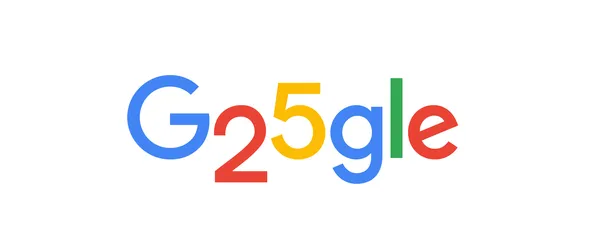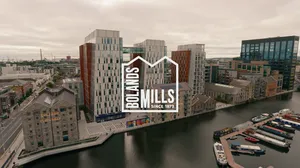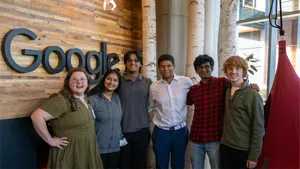Pop quiz: How well do you know Google?

For 25 years, you’ve been coming to us with your questions. Now we have some questions for you.
We started with Search in 1998, with the ambitious vision of organizing the world’s information. Today, 15 of our products are each used by over half a billion people every day. In honor of our milestone birthday, take this quiz to test your knowledge about all things Google. (And don’t worry — we won’t disqualify you for searching the answers on Google. 😉 🔍)
-
1/10

Unconventional from the start, the original Google server — which had 40 gigabytes of storage — was partially made of what material?
-
Click, click! Our original server’s encasement was built out of Lego bricks. Now we have data centers all over the world that keep the internet, including all your Google searches, humming along. They're not built with Legos, but they are built to be as energy efficient as possible and to help meet our goal of running on 24/7 carbon-free energy (CFE) by 2030.
Brush it off and keep lego-ing! The enclosure was actually built from Lego bricks. Now we have data centers all over the world that keep the internet, including all your Google searches, humming along. They're not built with Legos, but they are built to be as energy efficient as possible and to help meet our goal of running on 24/7 carbon-free energy (CFE) by 2030.
Click, click! Our original server’s encasement was built out of Lego bricks. Now we have data centers all over the world that keep the internet, including all your Google searches, humming along. They're not built with Legos, but they are built to be as energy efficient as possible and to help meet our goal of running on 24/7 carbon-free energy (CFE) by 2030.
Brush it off and keep lego-ing! The enclosure was actually built from Lego bricks. Now we have data centers all over the world that keep the internet, including all your Google searches, humming along. They're not built with Legos, but they are built to be as energy efficient as possible and to help meet our goal of running on 24/7 carbon-free energy (CFE) by 2030.
Click, click! Our original server’s encasement was built out of Lego bricks. Now we have data centers all over the world that keep the internet, including all your Google searches, humming along. They're not built with Legos, but they are built to be as energy efficient as possible and to help meet our goal of running on 24/7 carbon-free energy (CFE) by 2030.
Brush it off and keep lego-ing! The enclosure was actually built from Lego bricks. Now we have data centers all over the world that keep the internet, including all your Google searches, humming along. They're not built with Legos, but they are built to be as energy efficient as possible and to help meet our goal of running on 24/7 carbon-free energy (CFE) by 2030.
Click, click! Our original server’s encasement was built out of Lego bricks. Now we have data centers all over the world that keep the internet, including all your Google searches, humming along. They're not built with Legos, but they are built to be as energy efficient as possible and to help meet our goal of running on 24/7 carbon-free energy (CFE) by 2030.
Brush it off and keep lego-ing! The enclosure was actually built from Lego bricks. Now we have data centers all over the world that keep the internet, including all your Google searches, humming along. They're not built with Legos, but they are built to be as energy efficient as possible and to help meet our goal of running on 24/7 carbon-free energy (CFE) by 2030.
2/10

In 2013, we launched our first consumer hardware device. What was it?
-
You cast the right vote! Chromecast changed how people watched TV. Today, our consumer hardware device lineup includes a foldable phone, smartwatch and more!
Back then, Chromecast changed the way people watched TV. Today, our consumer hardware lineup includes a foldable phone, smartwatch and more!
You cast the right vote! Chromecast changed how people watched TV. Today, our consumer hardware device lineup includes a foldable phone, smartwatch and more!
Back then, Chromecast changed the way people watched TV. Today, our consumer hardware lineup includes a foldable phone, smartwatch and more!
You cast the right vote! Chromecast changed how people watched TV. Today, our consumer hardware device lineup includes a foldable phone, smartwatch and more!
Back then, Chromecast changed the way people watched TV. Today, our consumer hardware lineup includes a foldable phone, smartwatch and more!
You cast the right vote! Chromecast changed how people watched TV. Today, our consumer hardware device lineup includes a foldable phone, smartwatch and more!
Back then, Chromecast changed the way people watched TV. Today, our consumer hardware lineup includes a foldable phone, smartwatch and more!
3/10

Having an accurate map of the world in the palm of your hand wasn’t always the norm. What year did Google Maps launch turn-by-turn directions on mobile?
-
You’re on the right track! Turn-by-turn directions came to mobile just two years after we first launched Google Maps. Since then, we’ve amped up what a Map can do — like Immersive View and eco-friendly routing.
You’re a little off course! It was 2007 — two years after we first launched Google Maps. Since then, we’ve amped up what a Map can do — like Immersive View and eco-friendly routing.
You’re on the right track! Turn-by-turn directions came to mobile just two years after we first launched Google Maps. Since then, we’ve amped up what a Map can do — like Immersive View and eco-friendly routing.
You’re a little off course! It was 2007 — two years after we first launched Google Maps. Since then, we’ve amped up what a Map can do — like Immersive View and eco-friendly routing.
You’re on the right track! Turn-by-turn directions came to mobile just two years after we first launched Google Maps. Since then, we’ve amped up what a Map can do — like Immersive View and eco-friendly routing.
You’re a little off course! It was 2007 — two years after we first launched Google Maps. Since then, we’ve amped up what a Map can do — like Immersive View and eco-friendly routing.
4/10

We’ve published Street View imagery from every continent! What unconventional methods have we used to capture images of hard-to-reach places?
-
While the Street View Car has traveled 10 million miles (that’s like circling the earth more than 400 times!), it can’t reach spots like remote islands and mountaintops. Find out more wild ways we’ve captured Street View images around the world.
While the Street View Car has traveled 10 million miles (that’s like circling the earth more than 400 times!), it can’t reach spots like remote islands and mountaintops. Find out more wild ways we’ve captured Street View images around the world.
While the Street View Car has traveled 10 million miles (that’s like circling the earth more than 400 times!), it can’t reach spots like remote islands and mountaintops. Find out more wild ways we’ve captured Street View images around the world.
While the Street View Car has traveled 10 million miles (that’s like circling the earth more than 400 times!), it can’t reach spots like remote islands and mountaintops. Find out more wild ways we’ve captured Street View images around the world.
While the Street View Car has traveled 10 million miles (that’s like circling the earth more than 400 times!), it can’t reach spots like remote islands and mountaintops. Find out more wild ways we’ve captured Street View images around the world.
While the Street View Car has traveled 10 million miles (that’s like circling the earth more than 400 times!), it can’t reach spots like remote islands and mountaintops. Find out more wild ways we’ve captured Street View images around the world.
While the Street View Car has traveled 10 million miles (that’s like circling the earth more than 400 times!), it can’t reach spots like remote islands and mountaintops. Find out more wild ways we’ve captured Street View images around the world.
While the Street View Car has traveled 10 million miles (that’s like circling the earth more than 400 times!), it can’t reach spots like remote islands and mountaintops. Find out more wild ways we’ve captured Street View images around the world.
5/10

Today, AI powers so many of our products and features. What was one of the first ways we built AI into our products nearly 22 years ago?
-
AI, FTW! Now AI powers everything from multisearch to generative AI capabilities right in Search.
Did you mean spell check? Suggesting spelling corrections was one of the first ways we used machine learning. Now it powers everything from multisearch to generative AI capabilities right in Search.
AI, FTW! Now AI powers everything from multisearch to generative AI capabilities right in Search.
Did you mean spell check? Suggesting spelling corrections was one of the first ways we used machine learning. Now it powers everything from multisearch to generative AI capabilities right in Search.
AI, FTW! Now AI powers everything from multisearch to generative AI capabilities right in Search.
Did you mean spell check? Suggesting spelling corrections was one of the first ways we used machine learning. Now it powers everything from multisearch to generative AI capabilities right in Search.
6/10

Our quantum computing processor Sycamore has accomplished a whole lot. Which of these is not true?
-
Super! Our quantum supercomputers — which run on chips the size of a postage stamp — have demonstrated time crystals and beyond-classical computation.
The quantum chip is actually closer to the size of a postage stamp! As futuristic as it sounds, our quantum supercomputers have demonstrated time crystals and beyond-classical computation.
Super! Our quantum supercomputers — which run on chips the size of a postage stamp — have demonstrated time crystals and beyond-classical computation.
The quantum chip is actually closer to the size of a postage stamp! As futuristic as it sounds, our quantum supercomputers have demonstrated time crystals and beyond-classical computation.
Super! Our quantum supercomputers — which run on chips the size of a postage stamp — have demonstrated time crystals and beyond-classical computation.
The quantum chip is actually closer to the size of a postage stamp! As futuristic as it sounds, our quantum supercomputers have demonstrated time crystals and beyond-classical computation.
Super! Our quantum supercomputers — which run on chips the size of a postage stamp — have demonstrated time crystals and beyond-classical computation.
The quantum chip is actually closer to the size of a postage stamp! As futuristic as it sounds, our quantum supercomputers have demonstrated time crystals and beyond-classical computation.
7/10

Subsea cables — which are laid across the ocean floor to transmit information — are one way we increase internet connectivity. What do our deep sea cables have in common?
-
As you can sea, these are all true. Dive into even more facts about subsea cables here.
All these facts are connected. Dive into even more facts about subsea cables here.
As you can sea, these are all true. Dive into even more facts about subsea cables here.
All these facts are connected. Dive into even more facts about subsea cables here.
As you can sea, these are all true. Dive into even more facts about subsea cables here.
All these facts are connected. Dive into even more facts about subsea cables here.
As you can sea, these are all true. Dive into even more facts about subsea cables here.
All these facts are connected. Dive into even more facts about subsea cables here.
8/10

What Android update first brought the ability to use your voice by saying, “OK Google” to do things like send texts, get directions or play music on your phone?
-
Now Android is almost 15 and has over 3 billion users. And while we no longer name updates after tasty treats and the robot logo has evolved, we're still always working to make Android more helpful. Here’s a look at Android innovations over the years.
Now Android is almost 15 and has over 3 billion users. And while we no longer name our updates after tasty treats and our bugdroid logo has evolved, we're still always working to make Android more helpful. Here’s a look at Android innovations over the years.
Now Android is almost 15 and has over 3 billion users. And while we no longer name updates after tasty treats and the robot logo has evolved, we're still always working to make Android more helpful. Here’s a look at Android innovations over the years.
Now Android is almost 15 and has over 3 billion users. And while we no longer name our updates after tasty treats and our bugdroid logo has evolved, we're still always working to make Android more helpful. Here’s a look at Android innovations over the years.
Now Android is almost 15 and has over 3 billion users. And while we no longer name updates after tasty treats and the robot logo has evolved, we're still always working to make Android more helpful. Here’s a look at Android innovations over the years.
Now Android is almost 15 and has over 3 billion users. And while we no longer name our updates after tasty treats and our bugdroid logo has evolved, we're still always working to make Android more helpful. Here’s a look at Android innovations over the years.
9/10

In 2008, we announced Chrome via a webcomic. The browser’s source code is based on our free, open-source project called what?
-
You’ve got great sources. Chromium is built on web standards, meaning anyone can contribute to it and improve it. Today, it powers popular browsers, including Chrome.
404 Answer Not Found. Chromium was built on web standards, meaning anyone can contribute to it and improve it. Today, it powers many popular browsers, including Chrome.
You’ve got great sources. Chromium is built on web standards, meaning anyone can contribute to it and improve it. Today, it powers popular browsers, including Chrome.
404 Answer Not Found. Chromium was built on web standards, meaning anyone can contribute to it and improve it. Today, it powers many popular browsers, including Chrome.
You’ve got great sources. Chromium is built on web standards, meaning anyone can contribute to it and improve it. Today, it powers popular browsers, including Chrome.
404 Answer Not Found. Chromium was built on web standards, meaning anyone can contribute to it and improve it. Today, it powers many popular browsers, including Chrome.
10/10

Gmail launched on April Fools Day 2004. Jokes aside, it’s now one of our most popular products. What set Gmail apart from other email services when it first launched?
-
You’ve got the right answer! Nearly 20 years later and Gmail’s spam-filtering capabilities keep getting better. With the help of AI, Gmail stops more than 99.9 percent of spam from reaching inboxes. Here are even more ways we use AI to improve email. (And FYI: You can send emoji in email and schedule your emails to send at a later time with Gmail, too.)
Oh, spam! Nearly 20 years later, Gmail’s spam-filtering capabilities keep getting better. With the help of AI, Gmail stops more than 99.9 percent of spam from reaching inboxes. Here are even more ways we use AI to improve email. (And FYI: You can send emoji in email and schedule your emails to send at a later time with Gmail, too.)
You’ve got the right answer! Nearly 20 years later and Gmail’s spam-filtering capabilities keep getting better. With the help of AI, Gmail stops more than 99.9 percent of spam from reaching inboxes. Here are even more ways we use AI to improve email. (And FYI: You can send emoji in email and schedule your emails to send at a later time with Gmail, too.)
Oh, spam! Nearly 20 years later, Gmail’s spam-filtering capabilities keep getting better. With the help of AI, Gmail stops more than 99.9 percent of spam from reaching inboxes. Here are even more ways we use AI to improve email. (And FYI: You can send emoji in email and schedule your emails to send at a later time with Gmail, too.)
You’ve got the right answer! Nearly 20 years later and Gmail’s spam-filtering capabilities keep getting better. With the help of AI, Gmail stops more than 99.9 percent of spam from reaching inboxes. Here are even more ways we use AI to improve email. (And FYI: You can send emoji in email and schedule your emails to send at a later time with Gmail, too.)
Oh, spam! Nearly 20 years later, Gmail’s spam-filtering capabilities keep getting better. With the help of AI, Gmail stops more than 99.9 percent of spam from reaching inboxes. Here are even more ways we use AI to improve email. (And FYI: You can send emoji in email and schedule your emails to send at a later time with Gmail, too.)
You have answered 0/10 questions.
Want to brush up on even more Google facts? Read up on fun facts about our offices and data centers or check out a look at 25 years of Google by the numbers.

-







